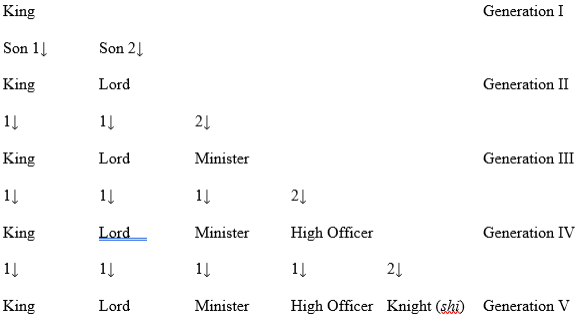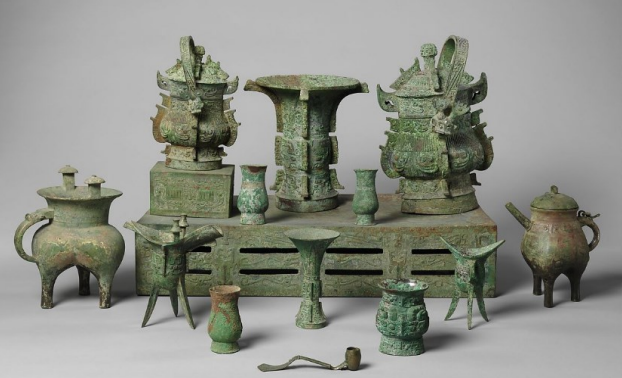2.3: The Zhou Aristocracy
- Page ID
- 135107
The Zhou leadership responded with reforms to keep the elite together and loyal to the king, even when he no longer regularly met them face to face. Based on the styles of Zhou bronze vessels, archaeologist Jessica Rawson thinks the reform occurred between about 950 and 850 BC, while Li Feng places it later, when the Zhou had disintegrated further.2 Instead of giving all sons and cousins equal status as before, the ritual reform distinguished “trunk” (senior) and “branch” (junior) patrilines. The eldest son by the primary wife – probably from the highest ranked family – headed the trunk lineage and retained the father’s status.

Younger sons had a critical role to play. They maintained their lineage’s ties to the Zhou king, because they could serve at the royal court, while the eldest son inherited rulership and ritual duties to ancestors in the fief itself.3 But despite their important role, in terms of rank, younger brothers were relegated to heading “branch” lineages, slipping down one notch in the hierarchy, until after five generations younger sons were only low-ranking officers or “knights” (shi). The younger sons of the knights might still bear arms and participate in the Six Arts of Zhou – rites, music, archery, charioteering, composition (mainly oral until about 400), and calculation – but they were no longer officially ranked as aristocrats.
Violence was still fundamental. The aristocracy defined membership by kinship and by participation in war, hunting, and bloody sacrifice to ancestors.4 Each rank had its ritual privileges in family worship and in burial. The senior line at each level worshipped the lineage founder on behalf of all, and the trunk ancestors five generations back. Each branch worshipped only its ancestors going five generations back. Other ancestors received offerings as a group, so they were still fed.
Grand burials for the higher Zhou ranks continued. In the Zeng domain, for instance, 106 tombs have been found, the grand ones along the ridge, and others on the hillside. The site includes two pits with complete chariots and many horses. Burying horses and chariots – the machines of war – showed that the descendent had enough and to spare: he was a power to be reckoned with. Likewise, Marquis Qi of Zeng was buried with 25 bronze vessels.5 Human beings were still sacrificed to accompany lords in death, too – sometimes buried alive.6 Such funerary display of prestige goods shored up power based on heredity and violence.

Economically, each elite lineage had its own estate with serfs who worked as servants, farmers, artisans, and shepherds. Estates and royal workshops might specialize in certain types of goods: leather, for instance, or chariots, jade ornaments, or tiles. Such goods, and small parcels of land and serfs were not sold, because there were no markets, nor was there any money (cowrie shells, used as money elsewhere in the world, were exchanged for display but did not operate as coins). But goods and lands could be exchanged. Since the king still nominally owned all land, property rights were unclear, so when lands were exchanged conflicts easily arose. Zhou farmers had tools of stone, bone, and shell; to irrigate fields they could divert small streams. They grew soybeans and millet, a little wheat and rice. Millet was made into ale. As well as silk for the ruling class they made hemp cloth for themselves. The ruling class ate pigs, chickens, and dogs, and sacrificed oxen and sheep (and ate the sacrifices in feasts). Scholars disagree about whether most farm labor was done collectively, under overseers, or by clans of serfs – probably it varied – and about exactly what kind of relation the working people I have been calling “serfs” (bondmen? slaves?) had with their lords. They certainly were not free people, however, even when they were highly skilled artisans.7
In addition to the titles of the feudal lords themselves, within the aristocracy and within aristocratic families, there were many, many ranks. Older sons and daughters outranked younger ones; primary wives outranked secondary wives (also called concubines); members of the senior branch of a family outranked the junior branches; old people outranked young people. All these factors intersected in any given relationship between two people to produce a highly complex internal ranking system – as in any aristocracy. Rules of etiquette that were part of ritual governed these relations; the classics speak of “three hundred major and three thousand minor rules of ritual.” The rules disciplined aristocrats to create ruling class coherence, reinforcing their sense of themselves as inherently better than the people they dominated. As a form of organization, the rules of rank also contributed to ideology.
Zhou state and society were both highly aristocratic: most people were born into their place in life, and political power lay in the hands of a tiny elite dominating serfs who worked their estates, and whose sense of superiority was supported by their possessions, their rituals, and their kin connections. Fed by the work of many farmers, fishermen, and herders with wood and stone tools, this was a world dominated by noble men and women who inherited status, political power, and wealth.



